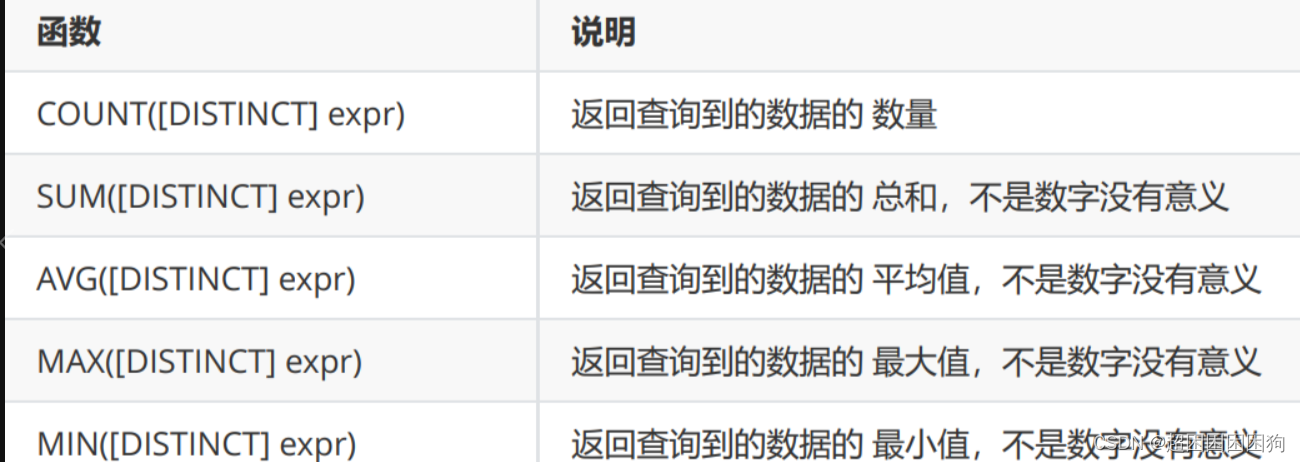一、 多表查询(跨表查询)
<br class="Apple-interchange-newline"><div></div>
子查询:分步查询链表查询:把多个有关系的表拼接成一个大表(虚拟表)inner joinleft joinright join
1.1 基于双下划线的查询
# 1 年龄大于35岁的数据res = models.User.objects.filter(age__gt=35)print(res)2 年龄小于35岁的数据res = models.User.objects.filter(age__lt=35)print(res)大于等于 小于等于res = models.User.objects.filter(age__gte=32)print(res)res = models.User.objects.filter(age__lte=32)print(res)年龄是18 或者 32 或者40res = models.User.objects.filter(age__in=[18,32,40])print(res)年龄在18到40岁之间的 首尾都要res = models.User.objects.filter(age__range=[18,40])print(res)查询出名字里面含有s的数据 模糊查询res = models.User.objects.filter(name__contains='s')print(res)是否区分大小写 查询出名字里面含有p的数据 区分大小写res = models.User.objects.filter(name__contains='p')print(res)忽略大小写res = models.User.objects.filter(name__icontains='p')print(res)res = models.User.objects.filter(name__startswith='j')res1 = models.User.objects.filter(name__endswith='j')print(res,res1)查询出注册时间是 2020 1月res = models.User.objects.filter(register_time__month='1')res = models.User.objects.filter(register_time__year='2020')
12 多表查询前期表准备
class Book(models.Model):title = models.CharField(max_length=32)price = models.DecimalField(max_digits=8,decimal_places=2)publish_date = models.DateField(auto_now_add=True)# 一对多publish = models.ForeignKey(to='Publish')# 多对多authors = models.ManyToManyField(to='Author')class Publish(models.Model):name = models.CharField(max_length=32)addr = models.CharField(max_length=64)# varchar(254) 该字段类型不是给models看的 而是给后面我们会学到的校验性组件看的def __str__(self):return self.nameclass Author(models.Model):name = models.CharField(max_length=32)age = models.IntegerField()# 一对一author_detail = models.OneToOneField(to='AuthorDetail')class AuthorDetail(models.Model):phone = models.BigIntegerField() # 电话号码用BigIntegerField或者直接用CharFieldaddr = models.CharField(max_length=64)
1.3 一对多外键增删改查
一对多外键增删改查增1 直接写实际字段 idmodels.Book.objects.create(title='论语',price=899.23,publish_id=1)models.Book.objects.create(title='聊斋',price=444.23,publish_id=2)models.Book.objects.create(title='老子',price=333.66,publish_id=1)2 虚拟字段 对象publish_obj = models.Publish.objects.filter(pk=2).first()models.Book.objects.create(title='红楼梦',price=666.23,publish=publish_obj)删models.Publish.objects.filter(pk=1).delete() # 级联删除修改models.Book.objects.filter(pk=1).update(publish_id=2)publish_obj = models.Publish.objects.filter(pk=1).first()models.Book.objects.filter(pk=1).update(publish=publish_obj)
1.4 多对多外键增删改查
如何给书籍添加作者?book_obj = models.Book.objects.filter(pk=1).first()print(book_obj.authors) # 就类似于你已经到了第三张关系表了book_obj.authors.add(1) # 书籍id为1的书籍绑定一个主键为1 的作者book_obj.authors.add(2,3)author_obj = models.Author.objects.filter(pk=1).first()author_obj1 = models.Author.objects.filter(pk=2).first()author_obj2 = models.Author.objects.filter(pk=3).first()book_obj.authors.add(author_obj)book_obj.authors.add(author_obj1,author_obj2)"""add给第三张关系表添加数据括号内既可以传数字也可以传对象 并且都支持多个"""删book_obj.authors.remove(2)book_obj.authors.remove(1,3)author_obj = models.Author.objects.filter(pk=2).first()author_obj1 = models.Author.objects.filter(pk=3).first()book_obj.authors.remove(author_obj,author_obj1)"""remove括号内既可以传数字也可以传对象 并且都支持多个"""修改book_obj.authors.set([1,2]) # 括号内必须给一个可迭代对象book_obj.authors.set([3]) # 括号内必须给一个可迭代对象author_obj = models.Author.objects.filter(pk=2).first()author_obj1 = models.Author.objects.filter(pk=3).first()book_obj.authors.set([author_obj,author_obj1]) # 括号内必须给一个可迭代对象"""set括号内必须传一个可迭代对象,该对象内既可以数字也可以对象 并且都支持多个"""# 清空# 在第三张关系表中清空某个书籍与作者的绑定关系book_obj.authors.clear()"""clear括号内不要加任何参数"""
1.5 正反向的概念
# 正向
# 反向
外键字段在我手上那么,我查你就是正向
外键字段如果不在手上,我查你就是反向
book >>>外键字段在书那儿(正向)>>> publish
publish >>>外键字段在书那儿(反向)>>>book
一对一和多对多正反向的判断也是如此
"""
正向查询按外键字段
反向查询按表名小写
_set
...
"""
二、子查询(基于对象的跨表查询)
# 1.查询书籍主键为1的出版社book_obj = models.Book.objects.filter(pk=1).first()# 书查出版社 正向res = book_obj.publish# print(res)print(res.name)print(res.addr)2.查询书籍主键为2的作者book_obj = models.Book.objects.filter(pk=2).first()书查作者 正向res = book_obj.authors # app01.Author.Noneres = book_obj.authors.all() # <QuerySet [<Author: Author object>, <Author: Author object>]>print(res)3.查询作者jason的电话号码author_obj = models.Author.objects.filter(name='jason').first()res = author_obj.author_detailprint(res)print(res.phone)print(res.addr)"""在书写orm语句的时候跟写sql语句一样的不要企图一次性将orm语句写完 如果比较复杂 就写一点看一点正向什么时候需要加.all()当你的结果可能有多个的时候就需要加.all()如果是一个则直接拿到数据对象book_obj.publishbook_obj.authors.all()author_obj.author_detail"""4.查询出版社是东方出版社出版的书publish_obj = models.Publish.objects.filter(name='东方出版社').first()出版社查书 反向res = publish_obj.book_set # app01.Book.Noneres = publish_obj.book_set.all()print(res)5.查询作者是jason写过的书author_obj = models.Author.objects.filter(name='jason').first()作者查书 反向res = author_obj.book_set # app01.Book.Noneres = author_obj.book_set.all()print(res)6.查询手机号是110的作者姓名author_detail_obj = models.AuthorDetail.objects.filter(phone=110).first()res = author_detail_obj.authorprint(res.name)"""基于对象 反向查询的时候当你的查询结果可以有多个的时候 就必须加_set.all()当你的结果只有一个的时候 不需要加_set.all()自己总结出 自己方便记忆的即可 每个人都可以不一样"""
三、 联表查询(基于双下划线的跨表查询)
# 基于双下划线的跨表查询1.查询jason的手机号和作者姓名res = models.Author.objects.filter(name='jason').values('author_detail__phone','name')print(res)反向res = models.AuthorDetail.objects.filter(author__name='jason') # 拿作者姓名是jason的作者详情res = models.AuthorDetail.objects.filter(author__name='jason').values('phone','author__name')print(res)2.查询书籍主键为1的出版社名称和书的名称res = models.Book.objects.filter(pk=1).values('title','publish__name')print(res)反向res = models.Publish.objects.filter(book__id=1).values('name','book__title')print(res)3.查询书籍主键为1的作者姓名res = models.Book.objects.filter(pk=1).values('authors__name')print(res)反向res = models.Author.objects.filter(book__id=1).values('name')print(res)查询书籍主键是1的作者的手机号book author authordetailres = models.Book.objects.filter(pk=1).values('authors__author_detail__phone')print(res)"""你只要掌握了正反向的概念以及双下划线那么你就可以无限制的跨表"""
四、 聚合查询
常见的统计总数,计算平均值的操作,可以用聚合函数来实现,常见的聚合函数有

聚合查询通常情况下都是配合分组一起使用的只要是跟数据库相关的模块 基本上都在django.db.models里面如果上述没有那么应该在django.db里面"""from app01 import modelsfrom django.db.models import Max,Min,Sum,Count,Avg# 1 所有书的平均价格# res = models.Book.objects.aggregate(Avg('price'))# print(res)# 2.上述方法一次性使用res = models.Book.objects.aggregate(Max('price'),Min('price'),Sum('price'),Count('pk'),Avg('price'))print(res)
五、 分组查询
MySQL分组查询都有哪些特点分组之后默认只能获取到分组的依据 组内其他字段都无法直接获取了严格模式ONLY_FULL_GROUP_BYset global sql_mode='ONLY_FULL_GROUP_BY'"""from django.db.models import Max, Min, Sum, Count, Avg1.统计每一本书的作者个数res = models.Book.objects.annotate() # models后面点什么 就是按什么分组res = models.Book.objects.annotate(author_num=Count('authors')).values('title','author_num')"""author_num是我们自己定义的字段 用来存储统计出来的每本书对应的作者个数"""res1 = models.Book.objects.annotate(author_num=Count('authors__id')).values('title','author_num')print(res,res1)"""代码没有补全 不要怕 正常写补全给你是pycharm给你的 到后面在服务器上直接书写代码 什么补全都没有 颜色提示也没有"""2.统计每个出版社卖的最便宜的书的价格(作业:复习原生SQL语句 写出来)res = models.Publish.objects.annotate(min_price=Min('book__price')).values('name','min_price')print(res)3.统计不止一个作者的图书1.先按照图书分组 求每一本书对应的作者个数2.过滤出不止一个作者的图书res = models.Book.objects.annotate(author_num=Count('authors')).filter(author_num__gt=1).values('title','author_num')"""只要你的orm语句得出的结果还是一个queryset对象那么它就可以继续无限制的点queryset对象封装的方法"""print(res)4.查询每个作者出的书的总价格res = models.Author.objects.annotate(sum_price=Sum('book__price')).values('name','sum_price')# print(res)"""如果我想按照指定的字段分组该如何处理呢?models.Book.objects.values('price').annotate()后续BBS作业会使用你们的机器上如果出现分组查询报错的情况你需要修改数据库严格模式
六、 F与Q查询
3. 1 F查询
1.查询卖出数大于库存数的书籍F查询"""能够帮助你直接获取到表中某个字段对应的数据"""from django.db.models import Fres = models.Book.objects.filter(maichu__gt=F('kucun'))print(res)2.将所有书籍的价格提升500块models.Book.objects.update(price=F('price') + 500)3.将所有书的名称后面加上爆款两个字"""在操作字符类型的数据的时候 F不能够直接做到字符串的拼接"""from django.db.models.functions import Concatfrom django.db.models import Valuemodels.Book.objects.update(title=Concat(F('title'), Value('爆款')))# models.Book.objects.update(title=F('title') + '爆款') # 所有的名称会全部变成空白
6.2 Q查询
Q查询
# 1.查询卖出数大于100或者价格小于600的书籍
# res = models.Book.objects.filter(maichu__gt=100,price__lt=600)
"""filter括号内多个参数是and关系"""
from django.db.models import Q
# res = models.Book.objects.filter(Q(maichu__gt=100),Q(price__lt=600)) # Q包裹逗号分割 还是and关系
# res = models.Book.objects.filter(Q(maichu__gt=100)|Q(price__lt=600)) # | or关系
# res = models.Book.objects.filter(~Q(maichu__gt=100)|Q(price__lt=600)) # ~ not关系
# print(res) # <QuerySet []># Q的高阶用法 能够将查询条件的左边也变成字符串的形式
q = Q()
q.connector = 'or'
q.children.append(('maichu__gt',100))
q.children.append(('price__lt',600))
res = models.Book.objects.filter(q) # 默认还是and关系
print(res)


)










 搭建Vue基础环境)





